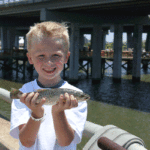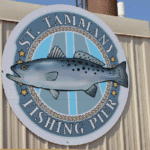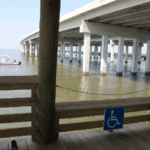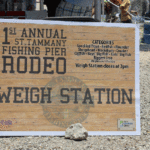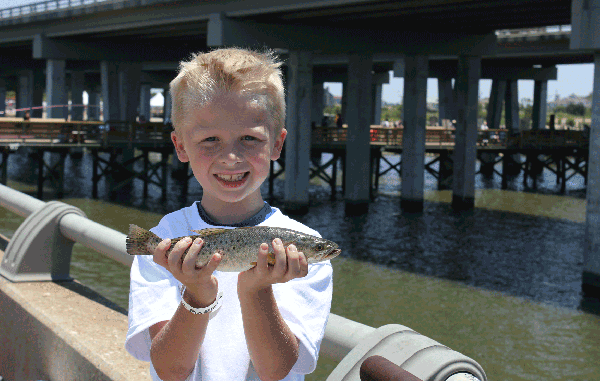
The I-10 twin spans had to be demolished after Hurricane Katrina, but all of that concrete didn’t go to waste. Instead, it was used to build the St. Tammany Fishing Pier.
When the winds of Hurricane Katrina began to subside, a grim view began to immerge on the northeastern shore of Lake Ponchartrain, one that will forever burn in our memories — the hallowed fishing grounds of the Interstate 10 twin spans had been severely damaged.
This damage would ultimately result in the old spans being replaced by two new bridges, and what was left of the old bridges were removed.
However, it is often said that every cloud has a silver lining and that obstacles can be stepping stones. And so it was with the last remaining sections of the old twin spans that were transformed into a monument of hope and new beginnings for the people of this area to enjoy for years to come.
The St. Tammany Fishing Pier was an idea born from a vision of “what could be,” and was created from what most would consider to be worthless debris left in Katrina’s wake.
On May 18, I attended the opening ceremony of the St. Tammany Fishing Pier. It was interesting to listen to the officials and dignitaries give moving speeches about how the project was conceived in the wake of Katrina by Kevin Davis (the St. Tammany Parish president at that time) and Bob Beck, a resident of Eden Isles.
But what I will remember most is the excitement in the eyes of the first group of young people from Northshore High casting their lines in the lake waters from the pier.
As I watched, I thought about how, seven years ago, no one would have ever believed such a victory could be achieved as we all stared in disbelief at the sight of the crumpled twin spans on our TVs.
Southeast Louisiana is home to one of the most-prolific fisheries in North America, and Lake Pontchartrain is a treasured part of that fishery. The waters in the eastern part of the lake have always been especially productive due to their proximity to the Rigolets and Chef Pass, where strong currents bring in clean, salty water from Lake Borgne and the Mississippi Sound.
Until the opening of the new pier, however, there were no public piers in that area of the lake. Anglers without boats had to fish from shoreline areas that were less than ideal and many times unsafe.
Now everyone can experience the opportunities that those with boats have.
To learn a little more about the pier and its facilities, I spoke with St. Tammany Parish Director of Public Information Suzanne Parsons.
“The popularity of the pier has greatly exceeded our expectations,” Parsons said. “We expected that we would have about 50 visitors on weekdays and 150 on weekends.”
Between the opening on May 18 through mid-July, the pier has had approximately 13,500 visitors. That’s an average of 225 visitors per day.
Parsons said reaching this unexpected milestone required a major investment.
“We have spent about $1 million so far, and have about $1 million more to complete the remaining phases of the pier that include permanent rest rooms and a small café that will be going out to bid shortly,” she said.
And there could be other features added.
“The things that people are asking most about are night fishing and season passes,” Parsons said. “We are working on both of these things and hope to offer them in the near future.”
Parsons also mentioned that work is under way to open the eastern twin span that extends farther into the lake. This span has been opened for special occasions, such as the grand opening, and hopefully will be permanently open by the end of 2012.
“We are most excited about how many families are coming out and enjoying the pier,” she said. “It is really great to see.”
If you and your family would like to try out the new pier, here is what you need to know.
Where is the pier located?
The pier is located on the east side of the I-10 twin spans off exit 261 (Oak Harbor Lakeshore Estates) on the shoreline of Lake Ponchartrain at 54001 E. Howze Beach Road in Slidell.
From the exit, there are signs that direct you to the pier. See map for details.
Fees
The entrance fees to fish from the pier for those 12 years old and older is $3. Children under 12 enter free. The entrance fee for non-fishing visitors 12 and over is $1.
Hours of operation
Summer hours of operation are 6 a.m. to 8 p.m.
Hours for other times of the year will be posted online at www.stpgov.org/gofishing.
Available facilities
The pier is a 700-foot-long wooden structure that begins at the shoreline and connects to the old twin-span bridges.
At the present time, the bridges are not open for fishing, but the eastern span is expected to open by the end of 2012 pending resolution of some safety concerns.
The pier is handicapped accessible, with several fishing stations accommodating wheelchairs.
The pier has great fish-cleaning station and many shaded areas with benches.
Rest rooms and vending machines are located on-site. The pier is fully lighted for night fishing, and officials hope to make it available to visitors in the near future.
Best gear should
You will have to bring your own fishing gear, tackle and bait.
Light- to medium-action rods and reels spooled with at least 15-pound-test line is recommended. Fishing around the pilings can fray your line easily, so stout line is necessary.
You will want to bring an ice chest with plenty of ice for your beverages and your catch.
A pier landing net is also a good idea. These nets look like a big crab net that you lower into the water under large fish to assist in bringing them up to the pier.
The pier has one for visitors to use, but to be on the safe side, it is best to bring your own.
And a pair of long-handled pliers is good to have to remove hardhead catfish and stingrays that are frequently caught.
A rolling cart or wagon to put all of your gear on is a great help.
What fish can I expect to catch?
Most of the common inshore saltwater species found in Southeast Louisiana can be caught at the pier.
The most common species caught have been black drum, sheepshead, croaker, speckled trout, white trout, flounder, redfish and channel mullet.
The largest reported fish caught at the pier so far has been a 59-pound black drum
The best fishing in the lake is normally during the spring and fall, when the fish are active and moving through the eastern part of the lake during their annual cycles.
Summer is the next best time, while the winter months are the slowest.
During many years, there is a “flounder run” in October and a “speckled trout run” in April. These are the times you will not want to miss.
Best baits
Most anglers fishing on the pier use shrimp. Live shrimp (when available) is the best bait choice for most species and can make the difference between catching and just fishing.
The pier does not currently offer any bait for sale, so you will have to bring your own.
Dockside Bait & Tackle (985) 707-2105 is nearby, and usually has live shrimp for sale from May through November.
If you are using live shrimp, you will need a way to keep your shrimp alive. There are several inexpensive bait buckets and pumps that can be purchased.
Fresh market shrimp are also a good choice, and are better than using shrimp that have been frozen.
Other live baits such as small croakers, pogies and finger mullet are excellent baits, but are hard to find unless you catch them yourself.
The use of cast nets is not allowed on the pier, however.
Artificial lures can also be successfully used, especially during the spring and fall months. Some of the favorites used by veteran lake fishers are Deadly Dudleys, Matrix Shad and Beatles. These baits should be fished slowly on the bottom around the pilings.
Best fishing rigs, tactics
Most experienced lake anglers believe bottom fishing in the lake is generally more productive than fishing under corks.
When fishing on the bottom, you should use either a drop rig or a Carolina rig.
A drop rig has a sinker located at the bottom of the rig, with one or two hooks (No. 6 treble is recommended) located above the sinker. The advantages of this type of rig is that it suspends the bait about 6 to 12 inches above the bottom where fish congregate, and this type of rig also helps keep the hooks from getting snagged on bottom debris.
Simply cast out, keep a tight line and make sure that the fish is on before setting the hook.
The Carolina rig uses an inline sliding sinker with an 18-inch shock leader and hook located below a barrel swivel. The advantage of the Carolina rig is that it allows the live bait to swim freely and when a fish strikes the bait it does not feel the weight of the sinker.
It is important to let the fish pick up the bait and run with it before setting the hook. Do not be in a hurry.
If artificial baits are used, a 3/8-ounce jighead is normally the proper weight for the lake, but the weight can be lightened if the tide is weak and hefted up the tide is strong.
The technique used in the lake with artificial baits is to cast the bait close to the pilings and let the bait sink all the way to the bottom (5 to 7 seconds). After the bait reaches the bottom, close the bail on the reel and start slowly lifting the bait off of the bottom, and then let it fall back to the bottom.
Most strikes will occur when the bait is falling.
What about crabbing?
Crabbing is allowed with the use of nets only — no crab traps.
Fish heads and chicken or turkey necks are the best baits.
When crabbing, courtesy should be exercised so the nets do not interfere with the enjoyment of others fishing on the pier.
Other information
Everyone who fishes on the pier must be properly licensed. You must have a basic fishing and saltwater license to fish in Lake Pontchartrain. Go to www.wlf.louisiana.gov/ to get licensing requirements.
Also, be careful to observe size and creel limits for each species caught.
And it is important to properly handle dangerous marine life that you catch such as stingrays and catfish. If you are not experienced in removing these fish, it is better to just cut your line and re-rig.
Visitors should bring a hat, sunscreen, sunglasses, insect repellent and non-skid shoes. During cooler months, dress warmly because it always feels colder over the water, especially in the wind.
Before heading out to the pier, you may want to check the Web site www.stpgov.org/gofishing for the latest information, fishing reports and other important information.
